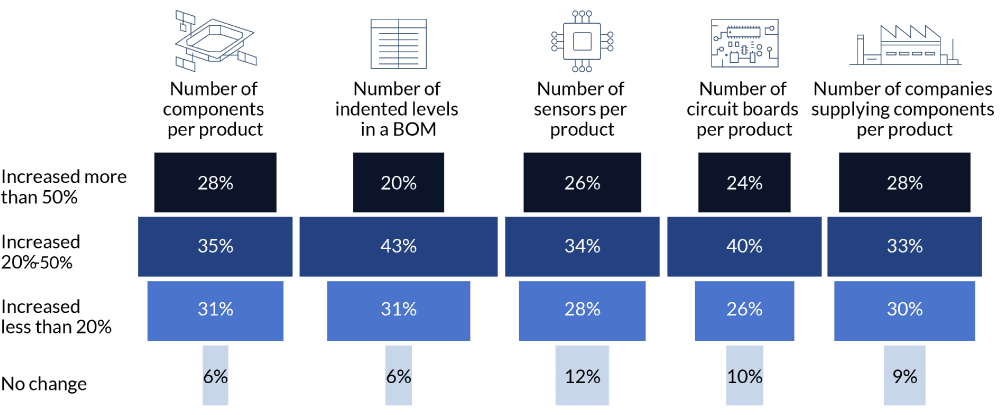- Solutions
ENTERPRISE SOLUTIONS
Infuse new product development with real-time intelligenceEnable the continuous optimization of direct materials sourcingOptimize quote responses to increase margins.DIGITAL CUSTOMER ENGAGEMENT
Drive your procurement strategy with predictive commodity forecasts.Gain visibility into design and sourcing activity on a global scale.Reach a worldwide network of electronics industry professionals.SOLUTIONS FOR
Smarter decisions start with a better BOMRethink your approach to strategic sourcingExecute powerful strategies faster than ever - Industries

Compare your last six months of component costs to market and contracted pricing.

- Platform
- Why Supplyframe
- Resources
Editor’s Note: This is the second in a series of six articles outlining findings from a NPI and Sourcing study performed in partnership with Lifecycle Insights. Click here to visit the series overview and access the other articles in the series.
Escalating consumer demand is forcing companies to develop smart, connected products with fewer resources and on shorter timelines. As a result, their NPI processes have become more complex.
To launch and deliver new products on time, organizations need to have all the pertinent information to support ideation, product definition, prototyping, detailed design, pre-production, and then manufacturing. Unfortunately, traditional methods and processes are not built for this level of complexity. So many organizations are pursuing NPI DX initiatives to help streamline the process, mitigate risks, and save on costs and time. Lifecycle Insights’ 2021 NPI and Sourcing Study asked survey respondents how that complexity was impacting their development projects.

Figure 1: Many aspects of products have dramatically increased in complexity, making the NPI process more difficult to execute successfully.
Lifecycle Insights’ NPI and Sourcing Study found:
- Products are more complex. Nearly two-thirds (63%) of survey respondents reported that products include a higher number of components and indented levels in product BOMs.
- Electronics complexity has also increased. More than half of survey respondents shared that the number of sensors and circuit boards required per product has increased by more than 20%.
- Companies rely on a greater number of suppliers to build their products. Sixty-two percent of respondents stated that the number of suppliers per product has also increased by more than 20%.
Increasing Overall Product Complexit
The study findings quantified the increasing complexity organizations must manage in their NPI processes. As a result, it has become more difficult to ensure NPI criteria are met deep into the overall product structure.
Findings showed a sharp rise both in the number of components and how deeply those components are indented in each product’s BOM. That deeper indentation means that a single product’s BOM has a greater number of end items. It also means the hierarchy of those components is deeper than before, extending into more complex, nested groupings.
The reason for this change is simple: Today’s customers expect far more from today’s products. Those expectations manifest as unique requirements that demand new engineering solutions. With more complexity come more functions. With more functions, more groupings. That, in turn, results in a deeper, more nested BOM overall.
Mitigating ongoing supply chain hurdles is more difficult, too. There are simply more components that need to be checked against their NPI criteria. And, as those components are buried deeper in the product’s BOM, companies must employ more due diligence to successfully mitigate any NPI risks.
Increasing Electronics Complexity
Organizations are also reporting heightened electronics complexity in new products. The 2021 NPI and Sourcing Study findings illustrate the effects of the transition from traditional, mechanical products to today’s smart, connected ones. Some of this movement, of course, is driven by increased demand for the kind of connected features enabled by electronics. But this transition is also driven by the products-as-a-service (PaaS) offerings where customers pay for a capability instead of purchasing a physical product. In these PaaS scenarios, the service provider needs to support high product performance to deliver a strong service. This requires remote connectivity and monitoring as well as Internet-of-Things (IoT) tracking.
As a result, companies must equip their products with more electronics and sensors, two component types that are frequently used in control systems. The sensors track the product’s environment and performance. Electronics systems process the sensor readings and send signals to electrically actuated components to change product behavior or offer new user interface options.
Applying NPI due diligence around sensors and electronics systems is more challenging today. Processors and other electronic components are in higher demand as whole industries shift toward smart, connected offerings. Additionally, disruptions like the COVID-19 pandemic and the recent spate of unusually inclement weather have hampered the ability of many organizations to secure such components. Companies have had to focus more attention on simply sourcing electronics.
Increasing Volume of Suppliers
The NPI and Sourcing Study uncovered another issue driving NPI process change: the need to work with more suppliers. That places an increased burden on manufacturers to coordinate and collaborate around their NPI criteria. For some, this increase in suppliers is merely the byproduct of each product requiring more unique components. For others, the increase can be linked to a conscious effort to avoid relying on too few suppliers when the industry, as a whole, is facing supply chain disruptions. But whether the increase in suppliers is due to one of these two reasons, or other matters entirely, the end result is that manufacturers need to work with more suppliers. This means more suppliers will be involved in their NPI processes, too.
This increase in the number of suppliers puts yet another strain on manufacturers. NPI and sourcing managers must assess a much larger volume of companies against a range of different risk factors—and they likely have to do so for a larger volume of product components. The end result is a remarkably heavier workload and a higher risk of missing various NPI criteria.
Driver Takeaways
Executing the NPI process is more complex than ever. NPI managers must mitigate a variety of risks across multiple axes, ranging from more components to more suppliers for each of those different components. These different factors act as amplifiers, making the overall process more taxing.
Manufacturing organizations cannot rely on the status quo to manage the NPI process in the face of this complexity. In fact, companies that do not proactively address these issues will face a far greater number of disruptions as they introduce new products. The end result will be missed launch or delivery windows, undercut margins, and even, in more extreme cases, a higher probability of regulatory penalties and fines.



